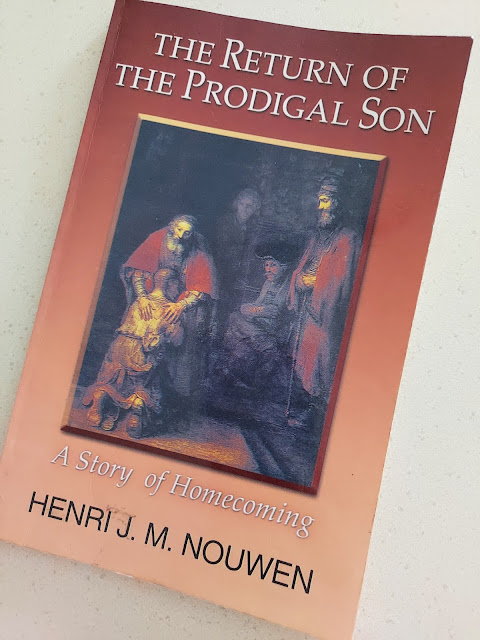I first came to know about the book, The Return of the Prodigal Son: A Story of Homecoming by Henri Nouwen in June 2001 at a seminar in church. I must have been drawn to its cover and purchased it almost immediately.
The book essentially captures Nouwen's reflections on a painting by renowned Dutch artist, Rembrandt (1606 - 1669) titled, The Return of the Prodigal Son. As the name suggests, the painting is Rembrandt's interpretation of the parable of the prodigal son (Luke 15: 11 - 32).
There were three parts in Nouwen's book that grabbed my attention:
From Chapter 7: “The true centre of Rembrandt’s painting is in the hands of the father. On them all the light is concentrated; on them the eyes of the bystanders are focused; in them mercy becomes flesh; upon them forgiveness, reconciliation, and healing come together, and through them, not only the tired son, but also the worn-out father find their rest.”
From Chapter 8: “It all began with the hands. The two are quite different. The father’s left hand touching the son’s shoulder is strong and muscular. The fingers are spread out and cover a large part of the prodigal son’s shoulder and back. I can see a certain pressure, especially in the thumb. That hand seems not only to touch, but, with its strength, also to hold. Even though there is a gentleness in the way the father’s left hand touches his son, it is not without a firm grip."
From Chapter 8: “How different is the father’s right hand! This hand does not hold or grasp. It is refined, soft, and very tender. The fingers are close to each other and they have an elegant quality. It lies gently upon the son’s shoulder. It wants to caress, to stroke, and to offer consolation and comfort. It is a mother’s hand.”
Nouwen’s reflections on Rembrandt’s masterpiece added a new dimension to my understanding of the parable of the prodigal son.
I made a mental note to look for the painting so that I can physically marvel at these observations that Nouwen had meticulously reflected on. I learnt that the painting is displayed at the State Hermitage Museum in Saint Petersburg, Russia. In 2001, the dream seemed out of reach for me who lived 8,670km away.
Fast forward to September 2018 and I was planning a trip to the Baltics and Poland. My return flight was from Kuala Lumpur to Helsinki after which I would travel south towards the capital cities of the Baltic nations – Tallinn, Riga and Vilnius; and onwards to Warsaw and Krakow in Poland.
While researching for the trip, I discovered that there was a free entry visa for travelers who enters Saint Petersburg by cruise ship or ferry.
I also discovered that Moby SPL Limited operates regular ferry services from Helsinki to Saint Petersburg.
I arrived at Saint Petersburg with a carefully planned itinerary. Since I had less than 48 hours (due to the free entry visa), I could only experience selected activities like search for beautiful underground metro stations:
and the Hermitage State Museum, or Hermitage, as it is popularly known as:
After getting off the ferry and checking into my hostel, I was already tired, but mustered enough energy to walk to the Hermitage.
After purchasing an entrance ticket, I picked up a museum guide and made my way into the building.
The first thing I did was to find my bearings and locate where the main exhibits were, especially Rembrandt’s Return of the Prodigal Son.
After wandering from room to room, from exhibit to exhibit, fatigue began to set in. The lack of clear and sufficient signages at the Hermitage didn’t help either. Information in the museum guide started becoming fuzzy.
Soon I came to the end of the building. Thinking that Rembrandt’s masterpiece was in the next building, I exited the building that I was in.
There was a personnel on duty and I asked her where exactly was Rembrandt’s Return of the Prodigal Son. When she said that the painting was in the building that I had just exited from, I realized that I had made a mistake. I asked whether I could re-enter the museum. She said that tickets are for single entry only, and that I would have to purchase another ticket. On no! I looked at my wrist watch and realized I didn’t have time to go to the main entrance of the Hermitage to do so as the museum was about to close. I was also tired and wanted to rest.
After mulling over the mistake that I had made, I made a difficult decision to leave the Hermitage without seeing the very painting that I had travelled 8,670km to Saint Petersburg for. I wouldn’t have time to return the next day as I had a packed itinerary. It was a painful decision but I had to learn to let go.
On the ferry back to Helsinki, I clutched Nouwen’s book and reflected on the lessons learnt from this trip.
I may have missed an opportunity to stand in awe before Rembrandt’s masterpiece, but perhaps it was God’s way of telling me that it is alright to let go of things that are not meant to be, or beyond my control. Anyway, this is an excuse to re-visit Saint Petersburg and discover more experiences (and lessons) that the magnificent city has to offer.











1 comment:
Sometimes things just do go the way we had planned but of course some things are better left unvisited so that you've got reason to go back for.
Post a Comment